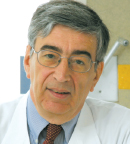In patients with HER2-positive early breast cancer, pathologic complete response rates after neoadjuvant therapy were higher with docetaxel plus carboplatin plus trastuzumab (Herceptin) plus pertuzumab (Perjeta), or TCH+P, than with ado-trastuzumab emtansine (Kadcyla) plus pertuzumab, or T-DM1+P, according to findings from the phase III KRISTINE trial.1
In the study, the TCH+P regimen was also associated with a higher rate of breast-conserving surgery. However, the T-DM1+P regimen was associated with a notably better safety profile and longer maintenance of health-related quality of life and physical functioning.

Though we are not ready to use this in the clinic, I hope that biomarker data will help us identify patients who can receive a nontraditional regimen and have a good outcome.— Sara A. Hurvitz, MD
Tweet this quote
“Neoadjuvant TCH+P achieved a superior [pathologic complete response] rate compared with T-DM1+P and was associated with a higher breast-conserving-surgery rate; however, neoadjuvant T-DM1+P had a more favorable safety profile,” said Sara A. Hurvitz, MD, of the University of California, Los Angeles, Medical Center in Santa Monica, at the 2016 ASCO Annual Meeting.
KRISTINE is the first phase III trial of a neoadjuvant regimen that omits standard chemotherapy for HER2-positive breast cancer. Ado-trastuzumab emtansine and pertuzumab both have marked antitumor activity in HER2-positive breast cancer, and they bind to different HER2 domains.
KRISTINE Study Design
Researchers at 68 centers in 10 countries enrolled 444 patients with HER2-positive tumors > 2 cm. Patients were randomly assigned to receive T-DM1+P or TCH+P, each given every 3 weeks for 6 cycles, followed by surgery and then 12 more cycles of the same HER2-directed regimen as adjuvant treatment.
Baseline characteristics were well balanced by age, world region, estrogen/progesterone receptor status, and stage. The primary endpoint was pathologic complete response by local assessment (ypT0/is, ypN0). Median follow-up was approximately 9 months.
Key Data
The pathologic complete response rate in the breast and lymph nodes was 56% in the TCH+P arm and 44% in the T-DM1+P arm (P = .0155), a nearly 12% difference, Dr. Hurvitz reported.
Pertuzumab-Containing Regimens
| TCH+P | docetaxel/carboplatin/ trastuzumab plus pertuzumab |
| T-DM1+P | ado-trastuzumab emtansine pluspertuzumab |
In patients with estrogen/progesterone receptor–negative disease, TCH+P yielded a pathologic complete response rate of 73%, compared to 54% in the T-DM1+P arm, and in estrogen/progesterone receptor–positive disease the respective pathologic complete response rates were 44% and 35%. In addition, more women in the TCH+P underwent breast-conserving surgery (53% vs 42%, P = .0228), and preplanned subgroup analysis showed that TCH+P was favored in all subgroups.
In contrast, neoadjuvant T-DM1+P was associated with longer maintenance of patient-reported health-related quality of life and physical functioning. Neoadjuvant T-DM1+P also had a more favorable safety profile, with a lower rate of grade 3–4 adverse events (13% vs 64%), serious adverse events (5% vs 29%), and adverse events leading to treatment discontinuation (3% vs 9%).
Findings in Context
In response to a question from a listener at the ASCO meeting, Dr. Hurvitz placed the KRISTINE findings into context with other studies of ado-trastuzumab emtansine plus endocrine therapy in the HER2-positive, estrogen/progesterone receptor–positive population. She indicated that the ADAPT study, reported at the San Antonio Breast Cancer Symposium in 2015, showed pathologic complete response rates of 41% for ado-trastuzumab emtansine alone and 41.5% for the antibody-drug conjugate plus endocrine therapy.2
“Our results were not so different for T-DM1/pertuzumab without endocrine therapy—about 35%,” she said. “This calls into question, ‘What’s pertuzumab adding to T-DM1, other than cost?”
The key message, she suggested, is that high pathologic complete response rates can be achieved in HER2-positive patients without them “losing their hair or having horrible gastrointestinal toxicity and febrile neutropenia.”
“We would have been very happy with these rates a decade ago in these patients,” she offered. “Though we are not ready to use this in the clinic, I hope that biomarker data will help us identify patients who can receive a nontraditional regimen and have a good outcome. It will just take time to sort that out.”
Biomarker data and longer-term follow-up from KRISTINE will be reported later. Several phase III studies are evaluating the use of ado-trastuzumab emtansine in early breast cancer: KATHERINE is comparing ado-trastuzumab emtansine to trastuzumab as adjuvant therapy in patients without a pathologic complete response, and KAITLIN is comparing T-DM1+P to trastuzumab/pertuzumab plus a taxane as adjuvant therapy.
WSG-ADAPT Trial
Also reported at ASCO were results from several other important neoadjuvant studies.

Ulrike Nitz, MD
In a poster, German investigators presented the final analysis of the randomized phase II WSG-ADAPT population of 134 HER2-positive, estrogen/progesterone receptor–negative patients receiving 12 weeks of dual blockade with trastuzumab plus pertuzumab with or without weekly paclitaxel.3 The pathologic complete response rate after trastuzumab/pertuzumab alone was 33.7%, “well within the range expected from prior trials,” but the rate rose to 90.5% with the addition of weekly paclitaxel (P < .001), reported Ulrike Nitz, MD, of the Evangelic Hospital Bethesda, Mönchengladbach, Germany.
“The addition of chemotherapy to dual blockade more than doubles the [pathologic complete response] rate in HER2-positive hormone receptor–negative early breast cancer,” she said. “The [pathologic complete response] rate of 90.5% is substantially higher than the expected 60%.”
The authors also suggested that the 34.4% pathologic complete response rate after pertuzumab/trastuzumab alone is “clinically meaningful,” especially for frail patients and those with small tumors. Toxicity was low in both arms.
ETNA Study
In HER2-negative patients, the randomized phase III ETNA study evaluated neoadjuvant nab-paclitaxel (Abraxane) vs paclitaxel in 695 women considered at high risk (triple-negative or luminal B–like).4 Patients received paclitaxel at 90 mg/m2 or nab-paclitaxel at 125 mg/m2 given during weeks 1, 2 and 3, followed by 1 week’s rest for 4 cycles, followed by 4 cycles of an anthracycline-based regimen.

Luca Gianni, MD
The primary endpoint was pathologic complete response, which was achieved by 22.5% of the nab-paclitaxel arm and 18.6% of the paclitaxel arm, a nonsignificant difference (hazard ratio [HR] = 0.77, P = .1858), reported Luca Gianni, MD, Director of the Department of Medical Oncology at the San Raffaele Cancer Center, Milan, Italy.
“The improved rate of [pathologic complete response] after nab-paclitaxel did not reach statistical significance,” he said. “And at the schedule and dose adopted in ETNA, the nab-paclitaxel regimen caused an overall rate of grade 3 and higher neuropathy of 4.5%, which was 2.7% more than with paclitaxel.”
In a multivariate analysis, the only factor associated with pathologic complete response was tumor subtype: Triple-negative tumors, as compared to luminal B–like tumors, had almost a fivefold likelihood of pathologic complete response with nab-paclitaxel (P < .0001). ■
Disclosure: Dr. Hurvitz has received grants from Genentech, Roche, Amgen, Bayer, Biomarin, Boehringer Ingelheim, Dignitana, GlaxoSmithKline, Lilly, Merrimack, OBI Pharma, Pfizer, Novartis, Medivation, and Puma Biotechnology, and reimbursement for travel from Lilly and OBI Pharma. Dr. Nitz has received honoraria from Agendia; honoraria and research funding from Amgen, Celgene, Genomic Health, Roche/Genentech, and Teva; and reimbursement for travel, accommodations, or expenses from Amgen and Roche/Genentech. Dr. Nitz also has had a consulting or advisory role with Genomic Health and Roche/Genentech, has served on speakers bureaus for Roche/Genentech and Teva, and has provided expert testimony for Genomic Health. Dr. Gianni has had a consulting or advisory role with AstraZeneca, Boehringer Ingelheim, Celgene, Genomic Health, GlaxoSmithKline, Merck Sharp & Dohme, Roche, Synaffix, Synthon, Taiho Pharmaceutical, and Tiziana Life Sciences and has patents, royalties, or other intellectual property associated with Roche.
References


